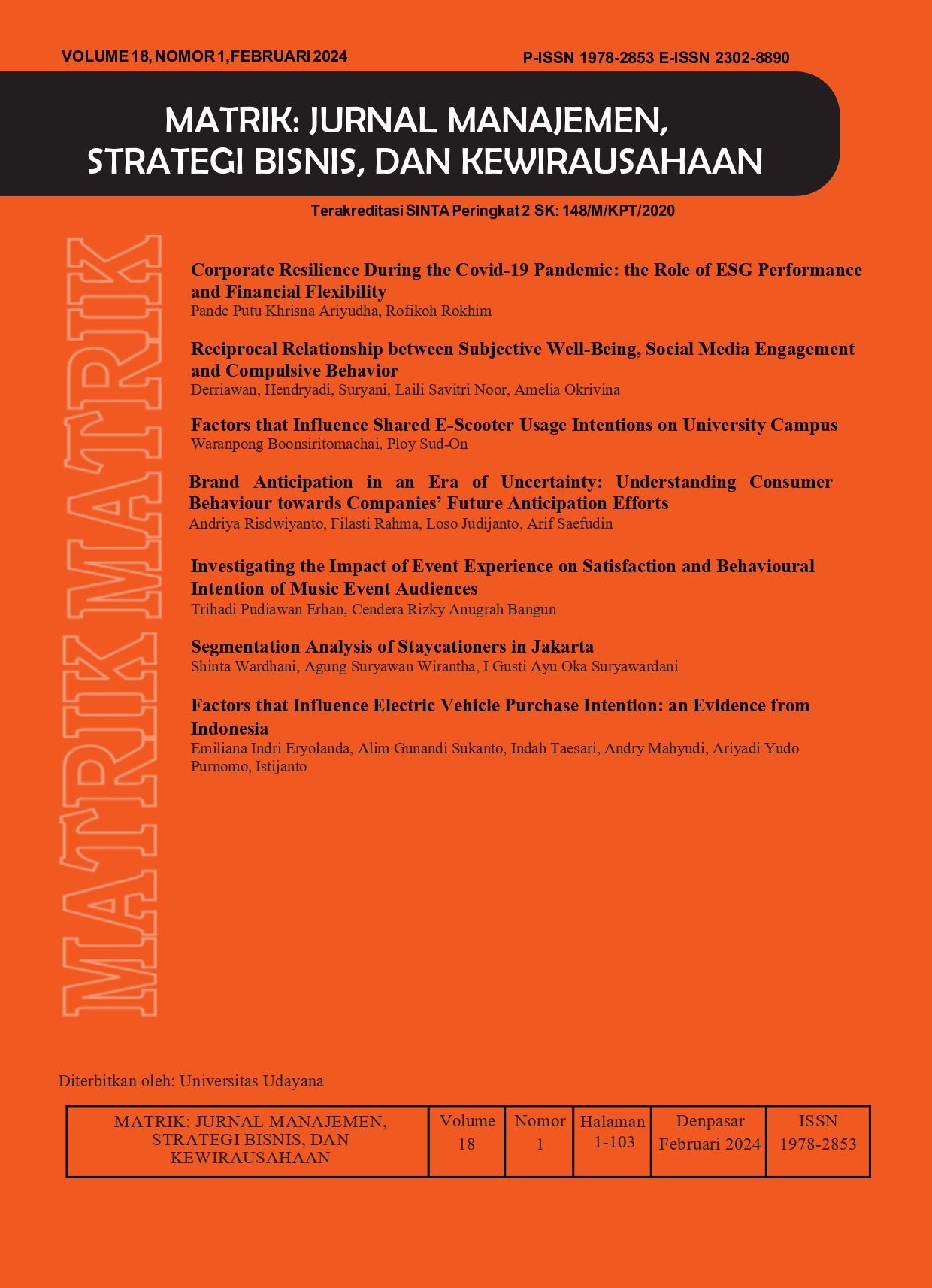Segmentation Analysis of Staycationers in Jakarta
Abstract
Staycation has been growing and continuously gaining popularity in Indonesia during and after the COVID-19 pandemic. This study aims to identify segments of staycation tourists/staycationers in Jakarta, one of Indonesia's most popular staycation destinations. Using quantitative methods, this study implements a proportional sampling design based on accommodation types with a total of 130 valid and reliable online questionnaire surveys. This study identifies factors and clusters using lifestyle variables from Activity, Interest, and Opinion (AIO) Model and examines their correlation with demographic, geographic, and behaviour segmentation. Data were analysed by descriptive statistics, including factor analysis, cluster analysis, discriminant analysis, and cross-tabulation analysis. The findings revealed four types of staycationers in Jakarta: (1) I-want-everything staycationers, (2) independent and attention seekers, (3) indulgent shopaholics, and (4) culture and local adventurers. Profiles and characters of each staycationer segment were analysed, giving significant knowledge about staycation market, particularly in Jakarta. Thus, this study offers valuable information for tourism and hospitality businesses to focus on the most potential market segment.
Keywords: AIO model, lifestyle segmentation, market segmentation, marketing, staycation
Downloads
References
Antara, M., & Dewi, N. P. A. Y. (2022). Segmenting, Targeting and Positioning: The Marketing Strategy of Jatiluwih Organic Red Rice, Bali. Pelawa Sari Denpasar Printing and Publisher.
Busnawir. (1982). Penentuan Sampel dalam Penelitian. LIPI.
de Bloom, J., Nawijn, J., Geurts, S., Kinnunen, U., & Korpela, K. (2017). Holiday travel, staycations, and subjective well-being. Journal of Sustainable Tourism, 25(4), 573–588. https://doi.org/10.1080/09669582.2016.1229323
Fitri, A. N. (2020, November 19). PHRI: Kerugian industri pariwisata karena pandemi sudah lebih dari Rp 100 triliun. https://industri.kontan.co.id/news/phri-kerugian-industri-pariwisata-karena-pandemi-sudah-lebih-dari-rp-100-triliun
Füller, J., & Matzler, K. (2008). Customer delight and market segmentation: An application of the three-factor theory of customer satisfaction on life style groups. Tourism Management, 29(1), 116–126. https://doi.org/10.1016/j.tourman.2007.03.021
Hair, J. F. (2010). Multivariate Data Analysis with Readings. (Vol. 7th). Prentice Hall.
James, A., Ravichandran, S., Chuang, N.-K., & Bolden, E. (2017). Using Lifestyle Analysis to Develop Lodging Packages for Staycation Travelers: An Exploratory Study. Journal of Quality Assurance in Hospitality & Tourism, 18(4), 387–415. https://doi.org/10.1080/1528008X.2016.1250240
Kotler, P., & Keller, K. L. (2017). Manajemen Pemasaran (Edisi 12). PT. Indeks.
Landau, S., Leese, M., Stahl, D., Everitt, B. S., Landau, D. S., & Leese, D. M. (2011). Cluster Analysis. John Wiley & Sons, Incorporated. http://ebookcentral.proquest.com/lib/griffith/detail.action?docID=661789
Le, D., & Phi, G. (2021). Strategic responses of the hotel sector to COVID-19: Toward a refined pandemic crisis management framework. International Journal of Hospitality Management, 94, 102808. https://doi.org/10.1016/j.ijhm.2020.102808
Lee, S.-H., & Sparks, B. (2007). Cultural influences on travel lifestyle: A comparison of Korean Australians and Koreans in Korea. Tourism Management, 28(2), 505–518. https://doi.org/10.1016/j.tourman.2006.03.003
Li, Q. (2022). Hotel Staycation Motivation: An Application of Q Methodology [University of Guelph]. https://hdl.handle.net/10214/26981
Lin, Z. (CJ), Wong, I. A., Kou, I. E., & Zhen, X. (Christine). (2021). Inducing wellbeing through staycation programs in the midst of the COVID-19 crisis. Tourism Management Perspectives, 40, 100907. https://doi.org/10.1016/j.tmp.2021.100907
Manente, M. (2006). Destination management and economic background: Defining and monitoring local tourist destinations. Enzo Paci Papers, 6.
Mill, R. C., & Morrison, A. M. (2012). The Tourism System (Vol. 7th). Kendal Hunt Publisher.
Ministry of Tourism and Creative Economy of Indonesia. (2021a). Staycation dan Roadtrip Masih Jadi Wisata Favorit 2021. https://pedulicovid19.kemenparekraf.go.id/staycation-dan-roadtrip-masih-jadi-wisata-favorit-2021/
Ministry of Tourism and Creative Economy of Indonesia. (2021b). Tren Pariwisata Indonesia di Tengah Pandemi. Ministry of Tourism and Creative Economy of Indonesia. https://kemenparekraf.go.id/ragam-pariwisata/Tren-Pariwisata-Indonesia-di-Tengah-Pandemi
Mursalina, M., Masbar, R., & Suriani, S. (2022). Impact of Covid-19 Pandemic on Economic Growth of the Tourism Sector in Indonesia. International Journal of Quantitative Research and Modeling, 3(1), 18–28. https://doi.org/10.46336/ijqrm.v3i1.261
Nugrahaeni, P. N. (2003). Perbedaan Kecenderungan Gaya Hidup Hedonis Pada Remaja Ditinjau dari Lokasi Tempat Tinggal. Universitas Muhammadiyah Surakarta.
Papatheodorou, A., Rosselló, J., & Xiao, H. (2010). Global Economic Crisis and Tourism: Consequences and Perspectives. Journal of Travel Research, 49(1), 39–45. https://doi.org/10.1177/0047287509355327
Plummer, J. T. (1974). The Concept and Application of Life Style Segmentation. Journal of Marketing, 38(1), 33. https://doi.org/10.2307/1250164
Purnamasari, T. (2020, July 17). Biar Nggak Gagal Paham, Ini Loh Arti Staycation! https://www.pegipegi.com/travel/biar-nggak-gagal-paham-ini-loh-arti-staycation/
Sadhale, M., & Sathe, S. (2021). Staycation as a marketing tool survival post covid-19 in fire star hotels in pune city. http://localhost:8080/xmlui/handle/123456789/9833
Scott, N., & Parfitt, N. (2005). Lifestyle Segmentation in Tourism and Leisure: Imposing Order or Finding It? Journal of Quality Assurance in Hospitality & Tourism, 5(2–4), 121–139. https://doi.org/10.1300/J162v05n02_07
Seyfi, S., Hall, C. M., & Saarinen, J. (2022). Rethinking sustainable substitution between domestic and international tourism: A policy thought experiment. Journal of Policy Research in Tourism, Leisure and Events, 1–15. https://doi.org/10.1080/19407963.2022.2100410
Sigala, M. (2020). Tourism and COVID-19: Impacts and implications for advancing and resetting industry and research. Journal of Business Research, 117, 312–321. https://doi.org/10.1016/j.jbusres.2020.06.015
Southan, J. (2021). Forget working from home, working from hotels is the next big thing. https://www.euronews.com/travel/2021/01/30/forget-working-from-home-working-from-hotels-is-the-next-big-thing
Srihadi, T. F., Hartoyo, Sukandar, D., & Soehadi, A. W. (2016). Segmentation of the tourism market for Jakarta: Classification of foreign visitors’ lifestyle typologies. Tourism Management Perspectives, 19, 32–39. https://doi.org/10.1016/j.tmp.2016.03.005
Suryani, T. (2008). Perilaku Konsumen. Graha Ilmu.
Thyne, M., Davies, S., & Nash, R. (2005). A Lifestyle Segmentation Analysis of the Backpacker Market in Scotland: A Case Study of the Scottish Youth Hostel Association. Journal of Quality Assurance in Hospitality & Tourism, 5(2–4), 95–119. https://doi.org/10.1300/J162v05n02_06
Todd, S., & Lawson, R. (2001). Lifestyle segmentation and museum/gallery visiting behaviour. International Journal of Nonprofit and Voluntary Sector Marketing, 6(3), 269–277. https://doi.org/10.1002/nvsm.152
Tore, O. (2021). Agoda Survey Finds out What People are Looking for in 2021. https://ftnnews.com/other-news/41051-agoda-survey-finds-out-what-people-are-looking-for-in-2021
Yesawich, P. (2010). Are Staycations Here to Stay? https://www.worldpropertyjournal.com/us-markets/vacation-leisure-real-estate-1/real-estate-news-peter-yesawich-travel-trends-2010-travel-report-y-partnership-tourism-trends-orlando-theme-parks-disney-world-sea-world-universal-studios-2452.php.
 This work is licensed under a Creative Commons Attribution-ShareAlike 4.0 International License.
This work is licensed under a Creative Commons Attribution-ShareAlike 4.0 International License.

















